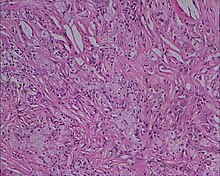Xanthoma

Xanthomas (from ancient Greek ξανθός (xanthos) = yellow) are harmless, orange-yellowish shimmering, nodular to plaque-like fat deposits in the skin. They are also known as yellow knots . They are localized collections of macrophages that have stored masses of fats and are transformed into foam cells . Xanthomas are caused by disorders of the lipid metabolism , mainly when the cholesterol level is high . Diseases with causes in other metabolic pathways can also be the cause of xanthomas. Such diseases are known as xanthomatoses . One example of this is cerebrotendinous xanthomatosis , a rare neurodegenerative disease in which the bile acid metabolism is disturbed.
The most important representative of the xanthomas is the Xanthelasma palpebrarum , which is localized around the eyes, especially on their upper lids.
to form
- Tendon xanthomas (e.g. on the Achilles tendons or extensor fingers)
- plane xanthomas (Xanthomata plana)
- tuberous xanthomas (Xanthomata tuberosa)
- Xanthelasma (on the eyelids or around the eyes)
- eruptive xanthomas (especially on the buttocks and extensor forearms)
- Palm line xanthomas
therapy
Xanthomas are locally removed surgically or with a laser . In the foreground, however, should be the therapy of the underlying lipid metabolism disorders, which can be responsible for more serious disorders, for example the development of arteriosclerosis . Occasionally, after a decrease in blood lipid levels, xanthomas also regress.
Web links
Individual evidence
- ↑ Moghadasian: Cerebrotendinous xanthomatosis: clinical course, genotypes and metabolic backgrounds. In: Clin Invest Med. No. 27 (1): 42-50 , 2004 ( researchgate.net ).
- ↑ Rafiq et al .: A neurological rarity not to be missed: cerebrotendinous xanthomatosis . In: Pract Neurol. No. 11 (5): 296-300 , 2011, doi : 10.1136 / practneurol-2011-000003 ( bmj.com ).
